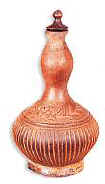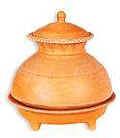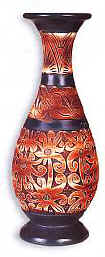|
Malay pottery are more than just household utensils. They are cultural artifacts borne out of talent, aesthetic sensitivity and religious fortitude of a people who have an uncanny ability to interpret nature in the most artistic way. The 'Mambong’ pottery in Kelantan, are fashioned from clay and characterized by a red shade. The pottery mainly consists of cooking utensils.
Sayung pottery in Kuala Kangsar, in the Perak State, is famous for its black-coloured gourd-shaped jars called ‘labu’. Often unglazed, Malay pottery can be divided into four types.
| Labu Sayong The Labu Sayong of Perak is the most famous. Made of clay, it is shaped like a gourd and used for containing water. Other similar items produced are the labu tela, labu kepala, labu gelugor tela and labu gelugor kepala. After these pots have been shaped and semi dried, they are smoothed with pebbles and decorated by engraving. When fully dried, they are fired in a furnace and removed. While still hot, they are covered with dried paddy husks to impart a black sheen. |
|
|
|
The Belanga Characterised by a round base and a wide rim, it is often used to cook curries. It is believed that the heat is distributed more evenly as its base is round.. Smaller than the belanga is the reddish brown periok which is often used to cook rice. |
| Buyung The buyung is typified by a bulbous body and a straight neck. Usually quite big, it functions as a water container. |
| Terenang The angular-shaped terenang used for carrying water is popular in the state of Pahang and Terengganu. Resembling brassware, it has a concave neck and a convex-shaped body. |
|
| Sarawak pottery is famous for its flower pots and vases that are adorned with ethnic tribal designs. |
Tours
 Discover Malaysia States of Malaysia History Monarch Government History People Culture Festivals Holidays Handicrafts Cuisine Weather Golfing FAQ |
|





